Profile Pictures and Online Identity

I was moving around my twitter account this morning, looking at my timeline, my direct messages, my recent followers, and the people I follow. I started looking carefully at all the avatars and thinking about the people behind them. The image on the right is the profiles of the most recent seven twitter accounts I've chosen to follow.
It's really interesting to see what people choose to use to represent them online. The simplest thing is a headshot and I suspect that's what the majority of people use when they are asked to upload a profile picture. That's what Kara Swisher chose (she's the top profile, my most recent follow).
But even with the headshot, some people go for the funny picture, adding some character to their profile. Mike Doughty (second profile) has his head on the table and some sort of box between him and the camera. Stuart Ellman (fifth profile) is dressed as the court jester (probably a halloween pic). Both of those profiles tell us a bit more about those two.
Some choose to use a photo of something or someone else. Lauren (fourth profile) seems to have chosen a family photo of some kind. Howie (sixth profile) has a photo of his friend and Springsteen's guitarist Nils Lofgren. We don't get to see these people's faces, but they are telling us something about them nonetheless.
I've been online since the early 90s and I've gone back and forth on what kind of profile I like to use. But for the past couple years, I've settled on the image that I now try to use everywhere online. It's my online brand and I stumbled on to it accidentally. I thought it might be interesting to share with all of you how that came about and what I learned from it.
In the middle of 2006, Howard Lindzon approached me about getting involved in a web video show he was going to produce called Wallstrip. In the initial incarnation of Wallstrip, there was going to be a daily video talking about the stock of the day, and then there was going to be about a dozen bloggers who would do a short post on what they thought of the stock as an investment idea.
Howard asked me to be one of those dozen bloggers. I thought about it for a while and then agreed to do it. Then, unbekownst to me, he asked an artist friend of his in Phoenix named Jenny to go on the web, find photos of each of the dozen bloggers, and draw up a sketch that he could use as their Wallstrip avatar. This was mine.
From the minute I saw it, I liked it. It uses my favorite color (green) as the backdrop and the eye color (my eyes are sometimes blue and sometimes green and sometimes something else). It looks like me, but not too much.
So I began to use it a bit here and there around the web as I set up new profiles. But by no means was it the only profile picture I used. For corporate oriented services like LinkedIn, I'd use my Union Square Ventures headshot. For social nets like Facebook, I'd use a regular headshot. I used a photo of me taking a photo on Flickr for a long time.
But then I started to realize that the Wallstrip avatar was becoming my online identity. People would comment about it all the time. Around the time we sold Wallstrip, Howard asked Jenny to do a real painting of it which I now have in my office at Union Square Ventures. It's a real conversation starter.
So sometime last year, I just decided to go with it everywhere. It's at the top of this blog and everywhere else I have an online identity. And I think that decision is having some important effects.
As I said earlier in this post, it's become my online brand. It's simple, small, and very recognizable. By putting it everywhere that I am online, I've used frequency and reach to power home that the avatar is me. It's become my visual handle and it's also a signature and a sign of authenticity.
But there's also a risk in standardizing on an online identity. Someone could grab that image and use it to pretend to be me. That's a concern and probably one reason why many people choose to change their profile picture/avatar on a regular basis. It hasn't happened to me yet, but I am sure it will and then I don't know what I am going to do about it.
Online identity is a big issue and a big opportunity for entrepreneurs on the web. It seems like Facebook is quickly becoming a major provider of online identity authentication and that's a smart move for them and a good thing for the web as a whole. But there is still a ton of opportunity out there to provide services in and around what Facebook and others are doing. Because online identity is powerful and becoming more intertwined with offline identity every day. My avatar is a good representation of that.

![Reblog this post [with Zemanta]](http://img.zemanta.com/reblog_b.png?x-id=74cc5060-65d1-4228-817b-a1f9a3d13a11)
![Reblog this post [with Zemanta]](http://img.zemanta.com/reblog_b.png?x-id=653aee00-0c25-4b1f-8f6c-ec2245eee791)

![Reblog this post [with Zemanta]](http://img.zemanta.com/reblog_b.png?x-id=38d21f86-91ce-4b1a-9d31-141c7aa40ef7)